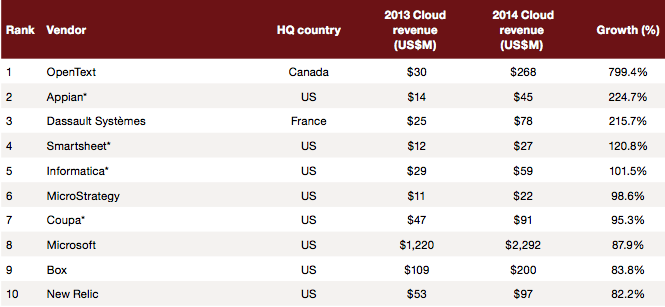The cloud model of delivering software is gathering momentum and becoming the preferred way of doing business for many customers, a new report from PriceWaterhouseCoopers (PwC) shows, and even traditional on-premises software companies are changing as a result.
As part of its 100 Global Software Leaders study, PwC took a snapshot of the top 25 fastest growing cloud companies — and Waterloo, Ont.-based OpenText came in on top of the list with $268 million in revenue for 2014. PwC looked at revenue growth between the 2013 and 2014 calendar years. OpenText’s most recent financial year report — its 2015 report filed June 30 — shows that revenue has continued to increase with OpenText reporting $605 million.

Founded in 1991, OpenText built its business on ERP software that is deployed on-premises and paid for with a licencing model. Yet its cloud-based, or software-as-a-service (Saas) is now more than double the revenue it makes from selling licences. (In its 2015 fiscal year, OpenText reported $294.2 million in revenue from licences.)
That’s still bucking the overall trend, according to PwC and data from analyst firm IDC. Licensed software still accounts for 91 per cent of revenues in the top 50 list, with cloud taking just a nine per cent slice of the pie. But OpenText serves as an example of what’s to come in the software industry, says Richard Jhang, a consulting partner at PwC.
“It will be quite difficult to undo what cloud computing has achieved,” he says. “It will only accelerate from this point on.”
Software buyers are beginning to appreciate the agility that is offered by cloud services, Jhang says. The traditional on-premises model for software took more upfront investment and multiple quarters to implement before a business strategy could be realized from it. But the cloud model makes it possible to implement within weeks and little to no upfront capitals, requiring only an operating budget commitment. Plus, the fact the same cloud software is being used by many other customers reassures new buyers that it will succeed for them. Combined with platform-as-a-service and infrastructure-as-a-service offerings, the cloud model allows businesses to quickly tap new resources as they’red needed.
“When you’re able to scale up faster or store more on a magnitude at a moment’s notice, that flexibility is beyond what used to be offered,” he says.
That means that many software businesses that are still relying on licensed revenue must adapt to the new cloud business model, or “get washed away by the oncoming deluge,” PwC states in its report. Namely, that means accepting lower average sales prices and worse margins on their offerings.
But beyond just rejigging the numbers, software vendors moving to a cloud service model must adjust their own operations. Rather than just providing support, cloud vendors have “customer success” teams to help their customers realize their goals and continue to be customers.
Vendors must demonstrate software can not only be implemented quickly, but show that its value in the business, and ensure maintenance and upgrades don’t affect service delivery. It’s something OpenText has done well, Jhang says.
“OpenText is worth noting because it offers more than just automation,” he says. “It’s information-centric software, it’s not just taking what used to be done on-premises and move it to the cloud.”
In PwC’s report, Gary Weisss, the senior vice-president of OpenText is interviewed. He says OpenText’s ability to demonstrate its compliance was key to gaining trust from its customers. OpenText has adopted a new training regimen for its support staff as well.
Despite the fact it has to juggle both licensed customers and subscription-based customers, Weiss says vendors can’t tell their customers what to do – they have to take an agnostic approach and choose the method best for them.
